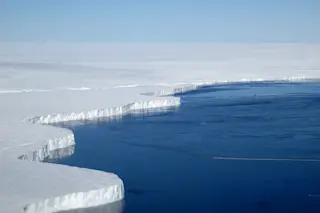The Getz Ice Shelf extends several miles into the ocean along the western Antarctic coast. The vertical face of the ice shelf is almost 200 feet high and is estimated to extend another 1,000 feet below the ocean surface. This photo was taken from a NASA DC-8 by Ted Scambos, Lead Scientist at the National Snow and Ice Data Center. Note: Thanks to a spring-break getaway, I'm just now catching up to this new research showing that warming ocean waters are threatening the stability of giant, floating shelves of ice fringing Antarctica. The post that follows offers a summary of the new findings, followed by a Q&A with the study's main author. By carving giant channels into the undersides of Antarctica's ice shelves, warming sea water is leaving some of them more vulnerable to disintegration — and raising new concerns about sea level rise. "We found that warm ocean water ...
Ocean warming threatens stability of Antarctic ice shelves by carving 'upside-down rivers' into their undersides
The Getz Ice Shelf in West Antarctica is at risk as warming ocean waters carve channels below, threatening global sea levels.
More on Discover
Stay Curious
SubscribeTo The Magazine
Save up to 40% off the cover price when you subscribe to Discover magazine.
Subscribe













